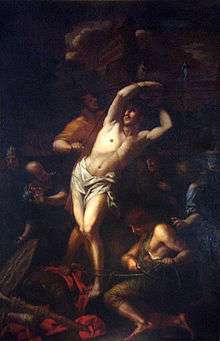Lazzaro Baldi
Lazzaro Baldi (c. 1624 – 30 March 1703) was an Italian painter of the Baroque period, active mainly in Rome.

Biography
Baldi was born in Pistoia and died in Rome. He is initially postulated to have been a pupil of a little known Francesco Leoncini in his native city.[1] But he soon moved to Rome to form part of the large studio directed by Pietro da Cortona, where Baldi became adept at fresco technique. He painted a David and Goliath for Alexander VII in the Palazzo Quirinale, as well as frescoes (1658) for the church of San Giovanni in Oleo and a San Giovanni in Patmos(1660–1665) for San Giovanni in Laterano. He also painted an altarpiece of the Martyrdom of St. Lazarus for the church of Santi Luca e Martina. In 1695, he became principe of the Accademia di San Luca in Rome.[2] He also worked in Camerino; Pistoia (an Annunciation for the church of San Francesco and a Repose in Egypt for the Umilta); and Perugia (Casa Borgia-Montemellino).[3] He died in Rome. As an engraver, Baldi is known for a plate on The Conversion of St. Paul.
One of his pupils was Giovanni Domenico Brugieri.[4]
References
- ↑ Guida di Pistoia per gli amanti delle belle arti con notizie, by Francesco Tolomei, 1821, page 152.
- ↑ Some Drawings by Lazzaro Baldi, by Nicholas Turner. The Burlington Magazine (1979). p. 154.
- ↑ F. Tolomei, page 152-153.
- ↑ Mazzarosa, Marchese Antonio (1843). Tipografia de Giuseppe Giusti, ed. Memorie e documenti per servire alla storia di Lucca, Volume 8.. Lucca; Googlebooks. p. 21.
- Bryan, Michael (1886). Robert Edmund Graves, ed. Dictionary of Painters and Engravers, Biographical and Critical (Volume I: A-K). York St. #4, Covent Garden, London; Original from Fogg Library, Digitized May 18, 2007: George Bell and Sons. p. 71.
- Italy cyberguide entry